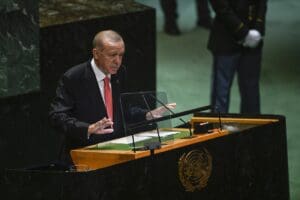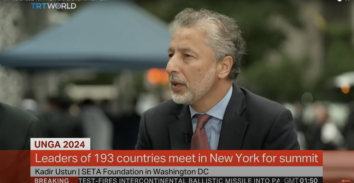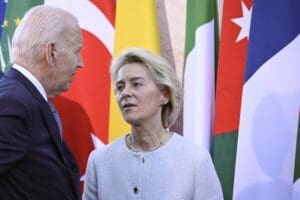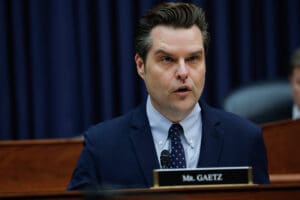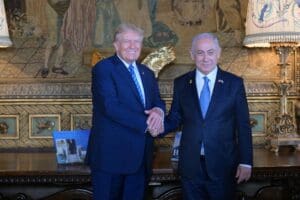US Recognition of Jerusalem: A Twenty-First Century Balfour Declaration

This piece was authored for the SETA Foundation at Washington DC by Geoffrey Aronson. He is a writer and analyst, specializing in Middle Eastern affairs. Aronson is chairman and co-founder of The Mortons Group.
Introduction
The US decision to recognize Jerusalem as Israel’s capital and to establish an embassy there is the most consequential American diplomatic action to address the Israel-Arab conflict in half a century. It ranks no less in importance than the decision of the Truman administration to recognize the fledgling state of Israel seven decades ago, and perhaps even the monumental Balfour Declaration offering critical imperial support to the establishment of a Jewish homeland in Palestine. Both declarations represent critical milestones in the effort to win recognition and support for core elements of the Zionist agenda.
Like these historic actions, Trump’s December 6, 2017 declaration recognizing Jerusalem as Israel’s capital and announcing the opening of the US embassy there represents a victory for Israel’s vision and the strategy devised for its realization. Like the earlier milestones in Israel’s history, this US action has dramatically altered and defined the diplomatic landscape, both with regard to Jerusalem and, more broadly, the parameters of the Israeli-Palestinian, Israeli-Arab, and US-Arab relationships.
Notwithstanding almost universal opposition internationally,[1] Washington’s blockbuster decision opens a new chapter in the history of the conflict, testifying not only to an even more intimate context for US-Israeli relations, but also establishing a new reality that all players in the region must accommodate as the future unfolds.
The Jerusalem Embassy Act
Trump’s action did not take place in a vacuum. His decision to move the US embassy from Tel Aviv, where it had been located since Israel’s establishment, to Jerusalem, was dictated by the US Congress. The Jerusalem Embassy Act (1995) became law notwithstanding President Clinton’s decision not to sign it. The Act recognized Jerusalem – without distinguishing between West Jerusalem, which became part of sovereign Israel upon its establishment and Israel’s declared but almost universally unrecognized capital in 1950, and the 70 sq. km East Jerusalem unilaterally annexed by Israel after its 1967 victory against Jordan – as Israel’s capital.
It is no secret that there has long been a political consensus in the American political establishment in favor of declaring support for recognition of Jerusalem – East and West – as Israel’s “eternal and undivided” capital. Israel too, for obvious reasons, counted the creation of such a consensus, in Washington if nowhere else, and notwithstanding perennial opposition to its execution, as a major diplomatic achievement.
Such declarations on Jerusalem may have roiled the international political environment but were viewed as de rigueuramong Washington’s welcoming political class. Politicians could count upon the President, whether Democrat or Republican, to maintain the diplomatic status quo. Passage of the law allowed Congress to declare itself in favor of a measure that was electorally popular, especially with the politically potent pro-Israel community, while enabling the president to circumvent it, as Congress knew he would. The law allows the President to invoke a six-month waiver of the application of the law and reissue the waiver every six months on “national security” grounds.
This script played out as expected. The waiver was repeatedly invoked by Presidents Clinton, Bush, and Obama. Even Donald Trump signed a waiver in June 2017, and indeed again in December 2017, in concert with his announcement. Trump’s personal and political interest in making such a declaration is well documented, offering a compelling context for the December 2017 announcement.
But the critical ingredient defining the landscape in which the decision was taken is one created by the Obama administration. For the first time since 1967, the incoming administration was bequeathed a diplomatic wasteland lacking any consensual diplomatic process, let alone agreement on the substantive issues contested by the parties. The diplomatic arena had been frozen for at least two years before Obama’s departure. There were no serious or direct talks, no agreed upon objective, no agreed framework for diplomatic engagement on Jerusalem, or indeed on any of the basket of “final status” issues that had engaged the parties for decades.
Trump inherited this completely barren diplomatic landscape, one defined by the failure of conventional ideas promoted by a self-regarded class of diplomats, politicians, experts, and analysts, unfettered by any concerns about upsetting a stagnant status quo.This environment was all but purpose-built for Trump’s disruptive modus operandi.
Trump became heir to, and has largely rejected, a record of diplomatic pronouncements on Jerusalem spanning more than half a century. During this time, US policy has been dynamic rather than static, evolving from pre-war adherence to the concept of an internationalized Jerusalem, to the postwar acceptance, if not recognition, of Jerusalem’s division. After 1967 and until the Trump decision, Washington progressively acknowledged Israel’s incremental control of the entire city – sovereignty in the West and a deluxe form of occupation in the East – and, even as it increasingly accommodated Israel’s vision of an eternally undivided Jerusalem under exclusive Israeli rule, pursued a negotiated solution as an integral part of a final status peace agreement between Israel and a State of Palestine.
The Unsettled Status of Jerusalem
In the wake of Israel’s creation, both Harry Truman and Dwight Eisenhower continued to view Jerusalem’s status as unsettled, and balked at recognizing (West) Jerusalem as the Israeli capital. “We continue to support, within the framework of the United Nations, the internationalization of Jerusalem and the protection of the holy places in Palestine,” declared Truman on October 24, 1948.[2]
The Eisenhower administration opposed unilateral Israeli actions in West Jerusalem, including Israel’s decision to move its foreign ministry to the city in 1952. It declared that, “The Government of the United States has adhered and continues to adhere to the policy that there should be a special international regime for Jerusalem which will not only provide protection for the holy places but which will be acceptable to Israel and Jordan as well as the world community.”[3]
The Johnson administration protested, without consequence, Israel’s effort to unilaterally change the city’s status, even as it implicitly acknowledged Israel’s right to take “provisional” steps there after the June 1967 war. Responding to the Knesset’s expansion of Israeli law to a unilaterally defined East Jerusalem on June 28, 1967, the State Department noted that, “The United States has never recognized such unilateral actions by any of the states in the area as governing the international status of Jerusalem.”[4]
Washington’s UN representative Arthur Goldberg explained on July 14, 1967 that, “The United States does not accept or recognize these measures as altering the status of Jerusalem…We insist that the measures taken cannot be considered as other than interim and provisional, and not as prejudging the final and permanent status of Jerusalem.”[5]
President Richard Nixon’s UN Representative Charles Yost, noted on July 1, 1969 that, “My Government regrets and deplores this pattern of activity [in Jerusalem], and it has so informed the Government of Israel on numerous occasions since June 1967. We have consistently refused to recognize those measures as having anything but a provisional character and do not accept them as affecting the ultimate status of Jerusalem.”
On March 23, 1976, President Gerald Ford’s UN envoy William Scranton, said, “Clearly, then, substantial resettlement of the Israeli civilian population in occupied territories, including East Jerusalem, is illegal under the [Geneva] Convention and cannot be considered to have prejudged the outcome of future negotiations between the parties on the location of the borders of States of the Middle East. Indeed, the presence of these settlements is seen by my Government as an obstacle to the success of the negotiations for a just and final peace between Israel and its neighbors.”[6]
By the end of President Carter’s term, US policy, despite its rhetorical opposition to Israel’s policy of annexation, had evolved to a position more closely resembling Israel’s. Washington emphasized the need to maintain Jerusalem’s “undivided” status. It focused on safeguarding the religious rights of all, while downplaying political challenges to Israeli sovereignty. And it continued to maintain that Jerusalem’s final status could only be determined by negotiation.
Ronald Reagan noted in 1982 that, “We remain convinced that Jerusalem must remain undivided, but its final status should be decided through negotiations.”[7] And in 1984, he stopped a Congressional move to relocate the embassy by threatening to veto proposed legislation that would recognize Jerusalem as Israel’s capital. Such opposition was not meant to favor Arab claims to the city, however. Alexander Haig, Reagan’s first secretary of state, declared the establishment of Palestinian sovereignty in East Jerusalem to be “unacceptable.”
President George Bush’s policies were more publicly critical of Israel’s settlement policies in the city than were Reagan’s. Yet, Secretary of State James Baker conceded that, “Jews and others can live anywhere, in the western or eastern parts of the city, which will remain undivided.”[8] The Bush administration did not revert to the pre-Reagan administration characterization of Israeli settlement activities as illegal, but Secretary of State James Baker characterized settlement as “de facto annexation.”[9] For the first time, however, the US agreed to the natural growth of the settlement population, including the 160,000 Israelis then residents in East Jerusalem, at an August 1992 meeting between President Bush and Prime Minister Yitzhak Rabin.
During the Clinton administration, opposition to Israel’s land confiscation and settlement activities in East Jerusalem waned to the point of indifference, including a refusal to characterize continuing settlement construction in East Jerusalem as a unilateral action, that all previous administrations opposed as a matter of principle, or even to characterize Israeli settlement in the city as “settlements.”
This “green light” to Israel’s policy of de factoannexation became more pronounced in the wake of the Oslo agreement between Israel and the PLO in September 1993. Administration officials argued that settlement construction and associated land expropriation in East Jerusalem should not be addressed by the UN Security Council, but rather were a bilateral concern of Israel and the Palestinian Authority.
The Clinton administration reiterated its defense of the policy supporting the “natural growth” of the settlement population. The State Department noted that, “In the past, settlement activity has created a great deal of tension and it has been a complicating factor in the Middle East, and in relations between Israel and the Palestinians and others…It’s also true that Israel and the Palestinians have decided to resolve this question, if they can, in the context of the final status talks… So it’s up to them now to resolve that problem.”[10]
The short-lived Clinton parameters established during negotiations in 2000 broke with the longstanding US support for a unified city and more broadly recognized the permanent nature of Israel’s settlement activities in the occupied East. They stated, “The general principle is that Arab areas are Palestinian and Jewish ones are Israeli. This would apply to the Old City as well.” The Palestinians would have sovereignty over the Haram and Israelis would have sovereignty over the Western Wall and the “space sacred to Judaism of which it is a part.”[11]
In the road map issued by the Bush administration in April 2003, the administration alluded to a shared capital in Jerusalem for both states. According to the first stage of the road map, the Israeli government was required to halt settlement expansion, including accommodation for natural growth throughout the occupied territories and Jerusalem. No such action was taken, however.
Instead, in an April 14, 2004 letter to Prime Minister Ariel Sharon, Bush reaffirmed recognition of the Israeli policy of “creating facts.” The letter noted that, “In light of new realities on the ground, including already existing major Israeli populations centers, it is unrealistic to expect that the outcome of final status negotiations will be a full and complete return to the armistice lines of 1949, and all previous efforts to negotiate a two-state solution have reached the same conclusion.”[12]
Barack Obama did not stray from the path established by his recent predecessors.
“Jerusalem will remain the capital of Israel,” he declared in 2008, “and it must remain undivided.”[13] However, in his last press conference as president, when asked about Trump’s promise to move the embassy, he warned that, “When sudden unilateral moves are made that speak to some of the core issues and sensitivities of either side, that can be explosive. That’s part of what we’ve tried to indicate to the incoming team in our transition process, is pay attention to this because this is…volatile stuff.”[14]
The combustible ingredients for protest emerged with the absence of a consensual diplomatic horizon and continued Israeli efforts to unilaterally determine Jerusalem’s future through the continuation of settlement and land confiscation and legislative attempts to distance Palestinians from access to or presence in the city. Palestinian disunity and despair at improving their predicament in Jerusalem, and more broadly throughout the West Bank and Gaza Strip, as well as emotive anniversaries celebrating victory (Israel) or defeat (Palestine), remain ever present. It was in this environment that Washington moved the embassy ceremony to coincide with Israel’s anniversary and that of the Palestinian Nakba.
Unilateralism and a Shattered Consensus
This latest era confers a new premium on Washington’s support for and encouragement of unilateral Israeli moves. It establishes Washington as a party overtly sabotaging an international consensus, however inadequate, forged over many decades, and blows a debilitating hole in the moribund Arab Peace Initiative, which proposed recognition of Palestinian statehood as a price for diplomatic recognition. It exposes an Arab and Palestinian incapacity to do more than proclaim support for a consensus the US has shattered.
Palestinians will find no comfort in boilerplate condemnations heard around the world or be assuaged by Washington’s limp suggestion that the Trump declaration on Jerusalem does not prejudge the shape of a diplomatic solution. Balfour, too, promised that Palestinian prospects would not be prejudiced by its support for Zionism, and we all know how that turned out.
An unlikely source of concern in what is otherwise a sea of triumphalism was soberly noted by Israel’s minister of security Avigdor Lieberman. The embassy relocation, he noted, “is important, historic and dramatic,” but he warned that, “there is no free lunch.” There is “a price for the national ambition and the realization of a vision. There will be a price for the opening of the US Embassy in Jerusalem and it is worth paying it.”[15]
Trump has taken some pains to limit the diplomatic fallout from his declaration. At an April 30, 2018 press conference in Amman, newly minted Secretary of State Mike Pompeo suggested that, “When the President announced that the United States would recognize Jerusalem as the capital of Israel, he also announced that the United States is not taking a position on boundaries or borders, and will support a two-state solution if the parties agree to it.”[16]
While in Jerusalem, Pompeo explained, “This step comes as Israel celebrates its 70th anniversary of independence and 70 years of recognition as steadfast support for Israel from the American people as well. By recognizing Jerusalem as the capital of Israel and the seat of its government, we’re recognizing reality. I also stress, as President Trump has said in December, the boundaries of Israeli sovereignty in Jerusalem remain subject to negotiations between the parties, and we remain committed to achieving a lasting and comprehensive peace that offers a brighter future for both Israel and the Palestinians.”[17]
Trump’s son-in-law, special envoy Jared Kushner, has taken great pains to win Saudi cooperation on a broad array of critical regional issues – from Iran and Syria to the shape of an Israel-Palestine “deal of the century” in which Jerusalem is excluded.[18] Trump, therefore, can be forgiven for assuming a Saudi carte blanchein his yet to be announced “deal of the century.” Pro formaprotests at the Jerusalem move at the April 2018 Arab Summit in Dhahran and the earlier Islamic Summit in Istanbul, have not discouraged Trump to “take Jerusalem off the table,” and chart his new course on Jerusalem.[19]
PLO chairman Mahmoud Abbas has been an unrepentant, if ineffectual, opponent of the Trump diplomatic offensive. Speaking at the April session of the Palestine National Council in Ramallah, Abbas declared, “We adhere to the constants, the two-state solution on the basis of international legitimacy, the state of Palestine on the borders of 67 and its capital East Jerusalem…and accept no other than East Jerusalem, which was occupied in ’67 – the capital of the State of Palestine.”[20] Abbas reiterated the long-held PLO position on the elements of a renewed diplomatic engagement, parameters that already failed to resonate in the more benevolent pre-Trump era.
The decision of the Trump administration to break with decades of US policy on Jerusalem is of a piece with its broader repudiation of past practice on Jerusalem, the Israel-Palestine conflict, and beyond. Along with an inadequate commitment to Palestinian sovereignty, unilateralism has been the foundational hallmark of Israeli policy. The endorsement of this demonstrates that, for partisans of the now faded hope for a historic reconciliation, there is a high price to be paid for the failure during these many decades to enshrine an agreement according to these principles between Israel and the PLO.
The Trump decision leaves Israel and Palestine on an unequal battlefield. While Trump’s vaunted “deal of the century” peace plan has yet to see the light of day, concrete decisions already taken – of which the decision on Jerusalem is most prominent – reveal an operational and doctrinal bias in favor of expansionist and unilateralist Israeli policies. These policies preclude the kind of consensual diplomatic engagement envisioned and supported by the international community. A plan based upon such conditions may well be unveiled. Reports in recent months suggesting an outline of Washington’s preferences are almost uniformly consistent with a bias favoring Israel’s policy of “creating facts on the ground” beyond the power of diplomacy to alter.
Conclusion
Jerusalem is not simply the focus of diplomatic dispute or an arena where conflicting visions of the future compete. Nor is it a museum important more for what has happened in the past than what will be in the future. Jerusalem is indeed a repository of ancient monuments to grandeur and piety that inspire adherents of the three great monotheistic faiths, but it is also a suffering metropolis of more than 800,000 people with problems rooted in the twenty-first century.
Sovereignty over the Haram al-Sharif is without question an important issue, but the very viability of the presumptive Palestinian capital of East Jerusalem – an area that today is little more than a moribund collection of isolated neighborhoods – is no less important to the viability of a healthy and vibrant Arab presence in the city. Palestinians who live in Jerusalem wage an unequal battle against a government prejudiced against their well-being as Palestinians no less than as citizens of the city. Israel, as a matter of national policy, constrains and complicates their development as the mirror image of the preference shown for policies that fortify Israel’s claim to rule the city. How long can an Arab Jerusalem survive – even one defined as the capital of Palestine – if all that it has to commend it are an impoverished minority and the crumbling relics of its bygone magnificence?
Jerusalem needs to be recognized as a metropolis that lives up to its lofty traditions and that provides a decent environment, not least of all a decent political environment, for all of its inhabitants. These are considerations that not only diplomats but also all those concerned for Jerusalem’s future need to ponder as they seek to fashion a viable future for the city and its people.
Opposition to Washington’s ill- considered decision is broad and deep. But in order to foster real results, it must more effectively challenge not only the Trump administration’s vision of the future but also Israel’s policies that seek to minimize Palestinians interests in the city and the long-expressed engagement in Jerusalem of the international community and the Arab and Muslim world.
Like the Balfour declaration, the Trump Declaration on Jerusalem represents a historic, new chapter in the history of the conflict. Great Britain’s ability, one century ago, to mold the diplomatic landscape according to its preferences stands today as a challenge not only to those opposing Washington’s and Israel’s vision of Jerusalem, but also a warning to that great power dictat’sof this nature, even after 100 years, remain incomplete.
[1]Dwyer, Collin, “U.N. Votes Overwhelmingly To Condemn U.S. Decision On Jerusalem,” NPR, last modified December 21, 2017. https://www.npr.org/sections/thetwo-way/2017/12/21/572565091/u-n-votes-overwhelmingly-to-condemn-trumps-jerusalem-decision
[2]“Statement by the President on Israel,” Harry S. Truman Presidential Library and Museum,accessed May 21, 2018. https://www.trumanlibrary.org/publicpapers/index.php?pid=2004
[3]Madsen, Wayne, “Israel Lobby Controlled Size of UN General Assembly,” Strategic Culture Foundation Online Journal,June 19, 2013. https://www.strategic-culture.org/pview/2013/06/19/israel-lobby-controlled-size-of-un-general-assembly.html
[4]“Circular Telegram From the Department of State to All Posts,” Department of State Office of the Historian,July 5, 1967. https://history.state.gov/historicaldocuments/frus1964-68v19/d344
[5]“1554thPlenary Meeting of the General Assembly,” United Nations General Assembly,July 14, 1967. https://unispal.un.org/DPA/DPR/unispal.nsf/0/66E65FB1AA7CFD3085257345004FFE4F
[6]“Excerpts from Scranton’s U.N. Speech,” The New York Times, March 25, 1976. https://www.nytimes.com/1976/03/25/archives/excerpts-from-scrantons-un-speech.html
[7]Cogan, Charles, “Slouching Toward Jerusalem,” Huffington Post, last modified May 25, 2011. https://www.huffingtonpost.com/dr-charles-g-cogan/slouching-toward-jerusale_b_408478.html
[8]Newton, Steven, “Obama may be JFK reincarnate, but he’s still a dangerous neophyte on foreign policy…,” The Delaware Libertarian, June 12, 2008. https://delawarelibertarian.blogspot.com/2008/06/obama-may-be-jfk-reincarnate-but-hes.html?m=0
[9]Kempster, Norman, “Baker Urges Arab-Israel Flexibility: Mideast: the secretary calls for moves to build confidence on both sides,” Los Angeles Times, March 18, 1991. http://articles.latimes.com/1991-03-18/news/mn-381_1_west-bank
[10]“Daily Press Briefing,” US Department of State, May 9, 1996. http://dosfan.lib.uic.edu/ERC/briefing/daily_briefings/1996/9605/960509db.html
[11]“The Clinton Peace Plan,” Israel Ministry of Foreign Affairs, December 23, 2000. http://mfa.gov.il/MFA/ForeignPolicy/MFADocuments/Yearbook13/Pages/226%20%20The%20Clinton%20Peace%20Plan-%2023%20December%202000.aspx
[12]Kessler, Glenn, “Israelis Claim Secret Agreement with U.S.,” The Washington Post, April 24, 2008. http://www.washingtonpost.com/wp-dyn/content/article/2008/04/23/AR2008042303128.html
[13]“Donald Trump: What past US presidents have said about recognising Jerusalem as Israel’s capital,” ABC News, last modified December 06, 2017. http://www.abc.net.au/news/2017-12-07/what-have-past-presidents-said-about-israel-and-jerusalem/9234736
[14]Mason, Jeff, “Obama suggests U.S. embassy move to Jerusalem could be ‘explosive’,” Reuters, last modified January 18, 2017. https://www.reuters.com/article/us-israel-palestinians-obama/obama-suggests-u-s-embassy-move-to-jerusalem-could-be-explosive-idUSKBN15234M
[15]“Lieberman: Israel Will ‘Pay Price’ For Embassy Relocation,” Jerusalem Post, last modified May 06, 2018. https://www.jpost.com/Israel-News/Lieberman-Israel-will-pay-price-for-embassy-relocation-553591
[16]Aronson, Geoffrey, “Obama’s Failure Set Stage for Trump’s Unilateral Israel Policy,” The American Conservative, last modified May 17, 2018. http://www.theamericanconservative.com/articles/obamas-neglect-set-stage-for-trumps-unilateral-israel-policy/
[17]“Remarks with Israeli Prime Minister Benjamin Netanyahu After Their Meeting,” U.S. Department of State, April 29, 2018. https://www.state.gov/secretary/remarks/2018/281299.htm
[18]Aronson, Geoffrey, “Did Saudi Arabia Just Try to Give the West Bank to Israel?” The American Conservative, last modified December 12, 2017. http://www.theamericanconservative.com/articles/did-saudi-arabia-just-try-to-give-the-west-bank-to-israel/
[19]Aronson, Geoffrey, “How Trump Gave a Green Light to Israel’s ‘One State Solution’,” The American Conservative, last modified January 11, 2018. http://www.theamericanconservative.com/articles/how-trump-gave-a-green-light-to-israels-one-state-solution/
[20]“The President: There is no peace without Jerusalem, the eternal capital of Palestine,” Alhaya,last modified April 30, 2018. http://www.alhaya.ps/ar_page.php?id=3c1f4b5y63042741Y3c1f4b5
Geoffrey Aronson is a writer and analyst, specializing in Middle East affairs. Aronson is chairman and co-founder of The Mortons Group. For more than 4 decades, he has been engaged as a commentator and participant in key political and security issues in the Middle East. He consults with a variety of public and private institutions dealing with regional political, security, and development issues. He was the director for Foundation for Middle East Peace and the editor of the bimonthly Report on Israeli Settlement in the Occupied Palestinian Territories until June 2014. He is the author of the following two books: From Side- show to Center Stage: US Policy towards Egypt and Israel and Palestinians, and The Occupied Territories: Creating Facts in the West Bank.









